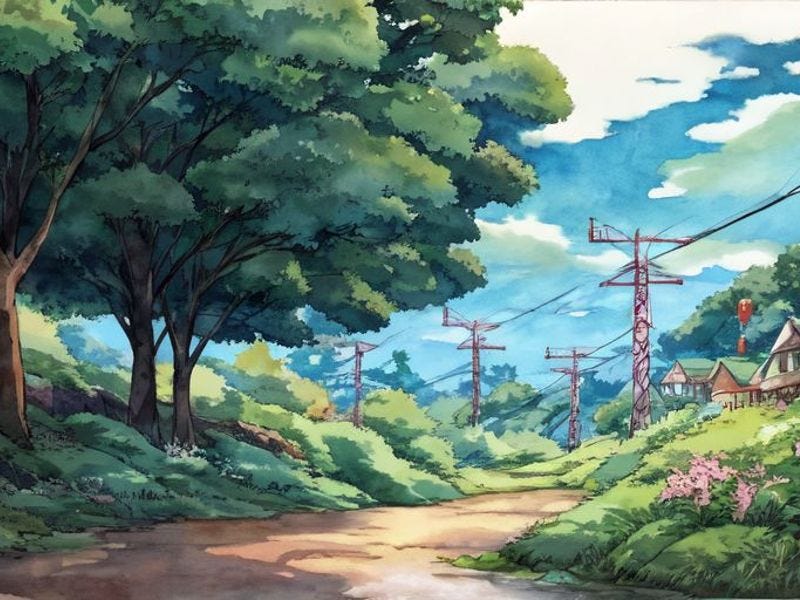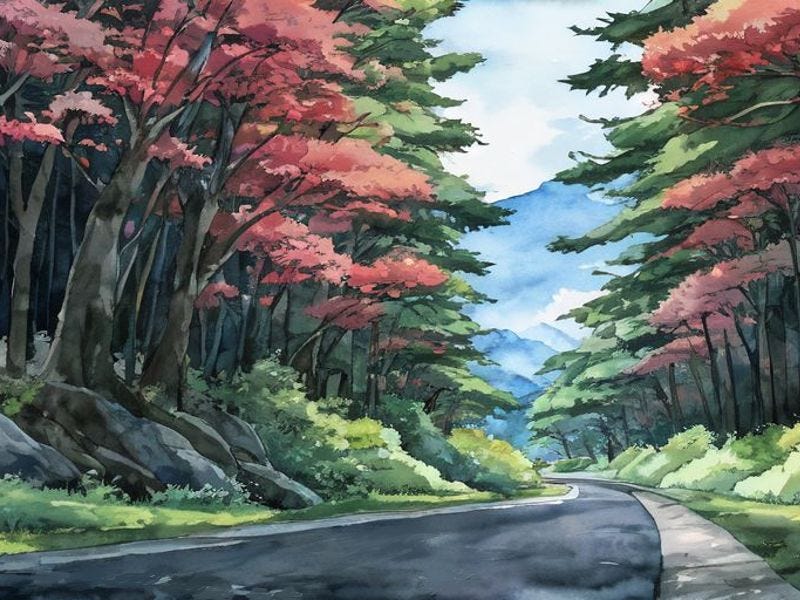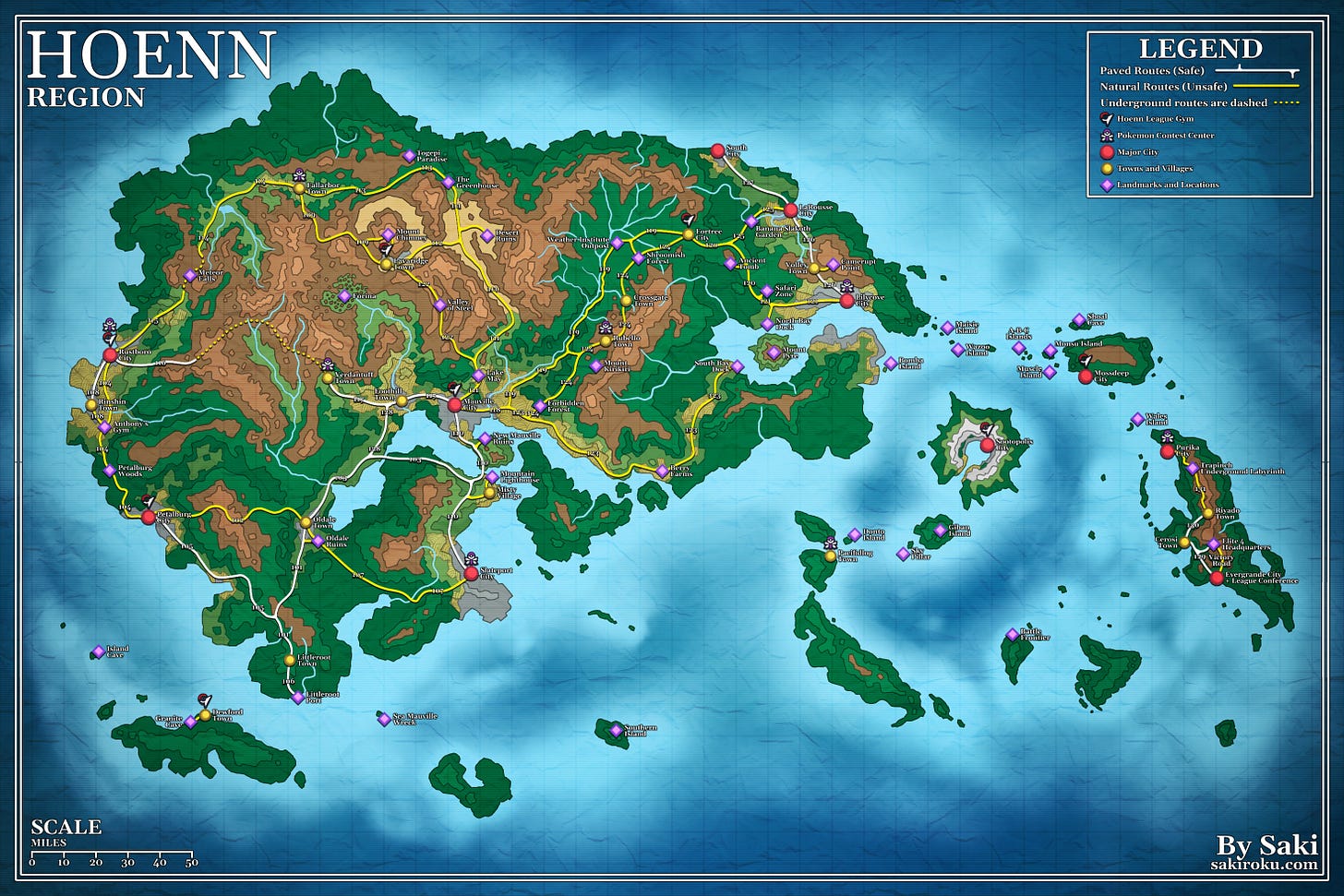Hoenn Forest Route Encounters — Pokémon RPG
Some system-agnostic tables for Pokémon games
I wanted to make some tables for Pokémon games.

And Pokémon role-playing campaigns have a lot of weird problems for GMs to handle. One is the matter of encounters.
For example, there’s a sort of perpetual tension between what Pokémon are available to be found & what Pokémon appear in things like descriptions of the environment. If you mention in the middle of a session that “a flock of Starly flies overhead”, there is a non-zero chance that somebody will decide they want one.
Traditional RPG encounter systems are bad at handling this. They generally assume that an encounter table are things such as skeletons, traveling merchants, or beleagured knights — encountered only occasionally, always notable when they are, and possibly quite dangerous or helpful. In contrast, Pokémon are as omnipresent as animals, frequently beneath notice, and only occasionally disruptive. That means two specific adjustments have to be made:
You need a mechanism to allow players to automatically discover easily-located Pokémon
You need a mechanism to allow players to manually discover rarer Pokémon
What kinda bewilders me is that I’ve never personally seen a Pokémon game system address this matter. I suspect PTU has made an attempt, but I bounced off it pretty hard for being (in my eyes) a bizarrely over-engineered mess.1
Why not just use the games’ tables?
Drawing directly from the game’s encounter tables on a per-route basis is a bad idea.
Each route only has a handful of Pokémon encounters. You will be making dozens of encounters across a campaign.
When you’re not playing a rigidly locked-down JRPG, nothing explicitly keeps a party from veering off into the wilderness & well off any beaten path. This means that per-route tables are bad ideas to begin with. The correct level of abstraction is biome.
There’s not really any good reason to restrict Pokémon to specific chunks of each region instead of treating them as distributed across biomes, unless you feel that gating anyone from ever meeting a Ralts or Volbeat in so-and-so place is critical to immersion — and if you want to stick so closely to the games, maybe you’d be better off playing them instead?
So since there’s no suitable existing options … let’s write our own!
Hoenn — Forest
1d6 Encounter Type
——————————————————————
1–4 Pokémon
5 Human
6 Hex featureT/N: We’re weighting towards Pokémon here. I’m also assuming your system has a means for determining rate of encounter. Since I know most Pokémon systems do not include this kind of info, a 2-in-6 chance per day is usually fine … depending heavily upon your intended game loop.
Pokémon
Roll 2d6 for row & 1d6 for column.
Common Entities: All entries in the Common rows can be found automatically with 4 hours of searching. Unusual entities have a 3-in-6 chance of being found per day spent searching.
T/N: Tweak these odds if you like.
Packs: Entries marked with (P) are found in a pack of 1d6 alongside its other evolution stages.
2d6 Rarity 1–2 3–4 5–6
————————————————————————————————————————————————————————————————————
2 Rare Shiftry Bellossom Vileplume
3 Unusual Nuzleaf Beautifly Breloom
4 Unusual Mightyena (P) Silcoon Gloom
5 Unusual Illumise Swellow Sawsbuck (P)
6 Common Poochyena (P) Shroomish (P) Deerling (P)
7 Common Wurmple Seedot Taillow
8 Common Zigzagoon (P) Oddish (P) Nincada
9 Unusual Volbeat Duskull Ninjask
10 Unusual Linoone Cascoon Ralts
11 Unusual Shedinja Duskox Kirlia
12 Rare Lotad Dusclops GardevoirT/N: Why choose this 2d6 & 1d6 structure? Because you can have between 1 & 3 columns of creatures with even odds of discovery, depending on biome density. 11 entries, up to 33, divided as 1-6, 1-3/4-6, or 1-2/3-4/5-6 for 1, 2, 3 columns.
Also, I apologize if these tables don’t display nicely in mobile. Substack doesn’t allow for proper tables, so we’re using codeblocks here.
Humans
2d6 Humans
————————————————————————
2 Team Aqua
3 Officer Jenny
4 Traveling Family
5 Hunter
6 Coordinator
7 Bug Catcher
8 League Trainer
9 Hiker
10 Researcher
11 Park Ranger
12 Team MagmaT/N: A lot of these are potentially redundant across multiple biomes, but a split-table structure where you include the generic options (i.e. Jenny) in a general table is clunkier than you’d think; it requires at least two rolls for any biome-specific result. So, you just kinda have to put up with entry duplication.
Locations
Moss-choked shrine to a forgotten Legendary or god. Crashed Devon Corp survey drone tangled in vines, intermittently broadcasting coordinates from a crippled comms set.
Massive hollow log lies across notable river; large enough for humans to walk through (if you duck). Resident Vileplume & Oddish demands bridge toll in meat/berries, spraying spores on anyone who tries to swim across instead.
Iridescent pond/lake where Illumise and Volbeat perform synchronized flight. The lake has been drying up from recent construction blocking rainflow. The iridescence is oil runoff.
A ruined home & watchtower now houses a Noctowl colony & a raspberry bush cluster. The tower is tall enough to overlook a major travel route, and the basement plummets deep into the underground.
Sunlight pierces a perfect shaft onto a single flower perpetually guarded by an unbelievably powerful Wurmple.
Glade of singing stones (“the living tunestones”) that emit low harmonic tones, disrupting & damaging electronic gear until repaired. Intensely attractive to Electric-types.
There’s a map too
And of course, you can always combine all this with my map of the Hoenn region.
I did design it to work well in a VTT, after all.
It’s a more general trend that RPGs, especially licensed games, rarely include sufficient GM tools to manage a true campaign. Most of them have no design vision greater than “D&D reskinned as Avatar/Star Wars/In Asia”. They’re all dungeon crawlers, in the end, or else tactical skirmish combat engines bolted onto a rigid linear narrative framework. Well, that could be a blog post unto itself.





